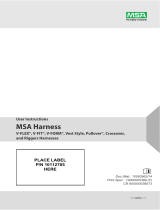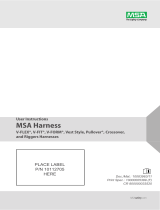
© Copyright 2005, DB Industries, Inc.
User Instruction Manual Climbing Strap
This manual is provided as the Manufacturer’s Instructions, and should be used as part
of an employee training program as required by OSHA.
WARNING: This product is part of a work positioning system. The users must read and follow the manufacturer’s instructions for each component
of the system. These instructions must be provided to the users of this equipment. The users must read and understand these instructions before
using this equipment. Manufacturer’s instructions must be followed for proper use and maintenance of this product. Alterations or misuse of this
product, or failure to follow instructions, may result in serious injury or death.
IMPORTANT: If you have questions on the use, care, or suitability of this equipment for your application, contact DBI/SALA.
1.0 APPLICATION
1.1 PURPOSE: The Climbing Strap (see Figure 1) is designed
for use as a pole climbing aid and as part of a work
positioning system. Do not use this product for fall arrest. In
situations where a fall may occur, use a separate personal
fall arrest system.
1.2 LIMITATIONS:
A. SYSTEM CAPACITY: The maximum capacity of the
Climbing Strap is a single user maximum of 350 lbs
including tools and equipment.
2.0 USE
2.1 Attach one of the snap hooks on the climbing strap to one of the hip D-rings on your body belt. Pass the climbing strap around the pole
that you are going to climb and attach the free snaphook to the hip D-ring on the other side of your harness. Make sure that the
adjustment buckles on top of the strap, away from the pole.
2.2 Check that the length of the strap allows a comfortable working position; if not, use the buckle to adjust the strap to the desired length.
3.0 INSPECTION
3.1 FREQUENCY:
• Before each use inspect equipment according to section 3.2 and 3.3 of these instructions.
• The climbing strap must be inspected by a competent person other than the user at least annually. See section 3.2 and 3.3 of these
instructions for guidelines.
IMPORTANT: If the climbing strap has been subjected to the forces of a fall arrest or impact forces it must be removed from service and
destroyed.
3.2 INSPECTION STEPS:
STEP 1. Inspect the climbing strap hardware (snap hooks and buckle). These items must not be damaged, broken, distorted, worn,
or have any sharp edges, burrs, or corrosion. Ensure the connecting hooks work properly. Hook gates must move freely and lock when
closed.
STEP 2. Webbing must be free of frayed, cut, or broken fibers. Inspect for tears, abrasions, mold, burns, and discoloration. Inspect
stitching for pulled or cut stitches. Broken stitches may be an indication the climbing strap has been impact loaded and must be removed
from service. The webbing has a blue outer cover and red inner core. If the outer cover is worn enough to expose the red inner core, the
strap must be removed form service and destroyed. Webbing must be free of knots, excessive soiling, heavy paint buildup, and rust
staining. Inspect for chemical or heat damage, indicated by brown, discolored, or brittle areas. Inspect for ultraviolet damage, indicated by
discoloration and splinters or slivers on the web surface. All of the above factors are known to reduce webbing strength. Damaged or
questionable webbing must be replaced.
3.3 If inspection reveals an unsafe condition, remove the equipment from service and destroy it, or contact an authorized service center for
repair.
Instructions for the following series products:
Climbing Strap
(See back page for specific model numbers.)
Figure 1 - Climbing Strap
Snap hooks Webbing
Adjustment Buckle

2
Form: 5902304
Rev: A
I S O
9 0 0 1
Certificate No. FM 39709
This instruction applies to the following models:
NOTE: Only DBI/SALA or parties authorized in writing may make repairs to this equipment. Authorization must be in writing.
4.0 MAINTENANCE, SERVICING, AND STORAGE
4.1 Clean the strap webbing with water and mild detergent. Wipe off hardware with a clean, dry cloth. Hang to air dry. Do not force dry with
heat. An excessive buildup of dirt, paint, etc. may prevent the equipment from working properly, and in severe cases, weaken the web to a
point where it should be removed from service. If you have questions concerning the condition of the equipment, or have doubt about
putting it into service, contact DBI/SALA.
4.2 Additional maintenance and servicing procedures must be completed by an authorized service center. Authorization must be in writing.
Do not disassemble the unit. See section 3.1 for inspection frequency.
4.3 Store the climbing strap in a cool, dry, clean environment, out of direct sunlight. Avoid areas where chemical vapors may be present.
Thoroughly inspect the energy absorbing lanyard after extended storage.
5.0 SPECIFICATIONS
• Performance Specifications:
Worker Capacity 350 lbs (158.8 Kg) maximum including tools and equipment
• Webbing material: 1 11/16 inch nylon web
Tensile Strength: 8,000 lbs min.
6.0 LABELING
6.1 The following labels must be present and fully legible:
USA Canada
3965 Pepin Avenue 260 Export Boulevard
Red Wing, MN 55066-1837 Mississauga, Ontario L5S 1Y9
Toll Free: 800-328-6146 Toll Free: 800-387-7484
Phone: (651) 388-8282 Phone: (905) 795-9333
Fax: (651) 388-5065 Fax: (905) 795-8777
www.salagroup.com www.salagroup.com
This manual is available for download at www.salagroup.com.
Additional model numbers may appear on the next printing of these instructions
1204030
1204031
1204032
ID Label
-
 1
1
-
 2
2
3M 1234030 User manual
- Type
- User manual
- This manual is also suitable for
Ask a question and I''ll find the answer in the document
Finding information in a document is now easier with AI
Related papers
-
3M 2105500 User manual
-
3M DBI-SALA® Delta™ Arc Flash Harness, Dorsal/Rescue Web Loops 1110780, Medium, 1 EA Operating instructions
-
3M DBI-SALA® Rollgliss™ R350 Rescue and Positioning Device, 3:1 Ratio 8902037, 1 ea Operating instructions
-
3M DBI-SALA® ExoFit STRATA™ Construction Style Positioning/Climbing and Retrieval Harness 1112549, 2X-Large, 1 EA Operating instructions
-
3M DBI-SALA® Delta™ Cross-Over Style Positioning/Climbing Harness 1103383, Small, 1 EA Operating instructions
-
DBI-SALA DBI-SALA® ExoFit NEX™ Oil and Gas Positioning/Climbing Harness 1113293, X-Large, 1 EA Operating instructions
-
DBI-SALA 2200401 Operating instructions
-
3M DBI-SALA® ExoFit STRATA™ Vest-Style Climbing Harness 1112508, Grey, Blue, X-Large, 1 EA Operating instructions
-
3M Protecta® Comfort Vest-Style Positioning/Climbing Harness 1161444, Black, X-Large, 1 EA/Case Operating instructions
-
3M DBI-SALA® ExoFit™ XP Vest-Style Climbing Harness 1110204, 2X-Large, 1 EA Operating instructions
Other documents
-
Guardian Halo Harness Operating instructions
-
Guardian Xplorer Harness Operating instructions
-
Guardian Fall Protection 21044 Installation guide
-
Guardian Seraph Construction Harness for Confined Space Operating instructions
-
Guardian Flame Retardant Premium Edge Construction Harness Operating instructions
-
Guardian Xplorer Harness Operating instructions
-
 V-Series V-FLEX™ Safety Harness Owner's manual
V-Series V-FLEX™ Safety Harness Owner's manual
-
 Workman Harnesses Owner's manual
Workman Harnesses Owner's manual
-
Guardian Series 1 Harness Operating instructions
-
Guardian Series 5 Harness Operating instructions



